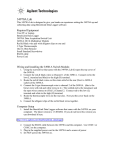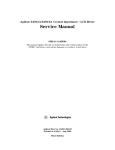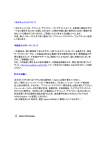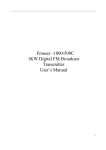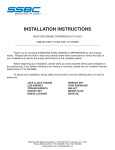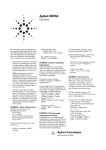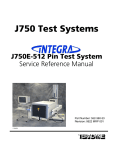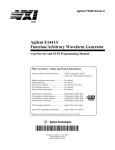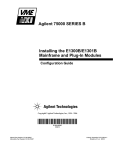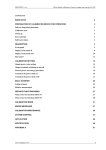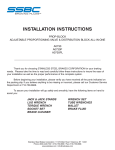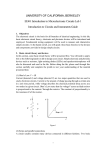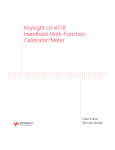Download HP 34812A BenchLink Meter User`s Guide
Transcript
User’s Guide Part Number 34812-90001 August 1994 For Warranty and Regulatory information, see the pages behind the Index. © Copyright Hewlett-Packard Company 1994 All Rights Reserved. HP 34812A BenchLink Software The HP 34812A BenchLink Software (HP BenchLink/Meter) package provides a communication link between a personal computer (PC) and the HP 34401A Multimeter (multimeter) or HP 53131/2A Universal or HP 53181A RF Counter (counters). HP BenchLink/Meter allows you to acquire, analyze, and save measurement data in a Windows environment. HP BenchLink/Meter’s key functions are: • Acquire measurements from the instrument for real time or post-test analysis. • Display measurement data graphically in real time strip charts or histograms. • Scale measurements to reflect engineering units such as temperature, pressure, etc. • Perform software limit testing on the measurement data. • Display statistical information. • Automatic and manual entry of information in the journal while acquiring measurement data. • Copy measurement data and graphs to the Clipboard. • Print measurement data as graphs. • Import data from other BenchLink applications for analysis (.CSV or .PRN format). • Export measurements as .CSV or .PRN files that may be read by external analysis/charting software applications. This block diagram shows the flow of data within HP BenchLink/Meter. Solid blocks indicate the components and processes of the application. HP 34812A BenchLink Software Conventions Used in this Guide Throughout this guide the following typeface and icon conventions are maintained to improve readability and enable you to quickly find the information you need. Ctrl+C Italics are used to indicate a hot key (shortcut) to perform a task or to give some useful information. The Toolbar and some paragraphs in this guide contain icons to represent an action. CANCEL b:\setup This typeface is used to indicate the label on a button or other control. This typeface indicates that input from the keyboard can be typed literally or indicates a menu command to be selected. For example: "Type b:\setup" or "Select File | Open Project... from the Menu Bar". File | Open Project... is separated by a bar because you must first select the File menu, then select Open. Recommended Reading This guide assumes that you have some experience using Microsoft Windows. If you don’t know how to use the basic features of Windows or are unfamiliar with terms such as click, double-click, resizing, and dragging, you may want to consult your Microsoft Windows User’s Guide. If you are new to the HP 34401A Multimeter, HP 53131/2A Universal or the HP 53181A RF Counter, please read your user’s guide before using HP BenchLink/Meter. The READBLM.WRI file This file contains up-to-date information about the HP BenchLink/Meter application. It is installed as an icon in the BenchLink program group during installation. Double-click the icon to view the contents of the file. 2 In This Book Chapter 1 - Installation describes how to install HP BenchLink/Meter and configure your instrument for operation. Chapter 2 - Quick Start describes how to start the software and provides a brief exercise to help you get started using HP BenchLink/Meter. Chapter 3 - Using HP BenchLink/Meter describes how to use HP BenchLink/Meter for the acquisition and scaling of measurement data. Limit testing is also detailed. Chapter 4 - Feature and Function Reference describes the features and functions available in HP BenchLink/Meter. Special file formats are described. Chapter 5 - Using with Other Applications describes how to use HP BenchLink/Meter with other Windows applications. Copying, importing, and exporting data are explained. Chapter 6 - Error and Information Messages lists possible HP BenchLink/Meter error and information messages with explanations and suggested solutions. 3 Table of Contents Conventions Used in this Guide Recommended Reading . . . . The READBLM.WRI file . . . In This Book . . . . . . . . . . . . . . . . . . . . . . . . . . . . . . . . . . . . . . . . . . . . . . . . . . . . . . 2 2 2 3 Chapter 1 - Installation Equipment Required . . . . . . . . . . . . . . Personal Computer Requirements . . . . . Computer Interface Requirements . . . . . Installing the HP BenchLink/Meter Software If you encounter problems . . . . . . . . . To Change the HP BenchLink/Meter Icon . . Freeing Disk Space . . . . . . . . . . . . . . To Remove HP BenchLink/Meter . . . . . . . . . . . . . . . . . . . . . . . . . . . . . . . . . . . . . . . . . . . . . . . . . . . . . . . . . . . . . . . . . . . . . . . . . . . . . . . . . . . . . . . 8 8 8 9 11 12 13 14 Chapter 2 - Quick Start HP BenchLink/Meter Components . . . . . Title Bar . . . . . . . . . . . . . . . . . . Menu Bar . . . . . . . . . . . . . . . . . Toolbar . . . . . . . . . . . . . . . . . . . Status Bar . . . . . . . . . . . . . . . . . Project Window . . . . . . . . . . . . . . Strip Chart Window . . . . . . . . . . . . Histogram Window . . . . . . . . . . . . Readout Window . . . . . . . . . . . . . Statistics Window . . . . . . . . . . . . . Analysis Window . . . . . . . . . . . . . Starting and Closing HP BenchLink/Meter Running a Sample Test Project . . . . . . . Creating a Sample Test Project . . . . . Displaying Measurement Data . . . . . . Saving Project and Measurement Data . . . . . . . . . . . . . . . . . . . . . . . . . . . . . . . . . . . . . . . . . . . . . . . . . . . . . . . . . . . . . . . . . . . . . . . . . . . . . . . . . . . . . . . . . . . . . . . . . . . . . . . . . . . . . . . . . . . . . . . . . . . . . . . . . . . . . . . . . . . . . . . . . . . . . . . . . . . . . . . . . . . . . . . . . . . . . . . . . 16 16 17 17 17 17 18 18 18 18 19 19 20 20 23 26 Chapter 3 - Using HP BenchLink/Meter About the HP BenchLink/Meter Application Making Standard Measurements . . . . . . Function and Range Options . . . . . . . Resolution Options . . . . . . . . . . . . Acquisition Options . . . . . . . . . . . . Running a Test with Limits Enabled . . . . Configuring Limit Testing . . . . . . . . Using the BenchLink/Launch Program . . . . . . . . . . . . . . . . . . . . . . . . . . . . . . . . . . . . . . . . . . . . . . . . . . . . . . . . . . . . . . . . . . . . . . . . . . . . . . . . . . . . . . . . . . . 30 31 31 33 34 36 36 38 4 . . . . . . . . . . . . . . . . . . . . . . . . . . . . Chapter 3 - Using HP BenchLink/Meter (continued) Using HP BenchLink/Meter to Scale Data . . . . . . . . Linear Scaling . . . . . . . . . . . . . . . . . . . . . . Lookup Tables . . . . . . . . . . . . . . . . . . . . . . Equation Libraries . . . . . . . . . . . . . . . . . . . . Printing Windows and Measurements . . . . . . . . . . . Printing Strip Chart, Histogram, or Analysis Windows Printing Journal or Statistics Window Information From Other Applications . . . . . . . . . . . . . . . . Saving Project Information . . . . . . . . . . . . . . . . . Saving the Project as a .PRJ File . . . . . . . . . . . . Saving Measurement Data as .CSV or .PRN Files . . . Using HP BenchLink/Meter Help . . . . . . . . . . . . . Configuring the Interface . . . . . . . . . . . . . . . . . . Configuring Your Instrument . . . . . . . . . . . . . . . HP 34401A Multimeter . . . . . . . . . . . . . . . . . HP 53131A/53132A/53181A Counters . . . . . . . . . . . . . . . . . . . . . . . . . . . 40 40 41 43 44 44 . . . . . . . . . . . . . . . . . . . . . . . . . . . 44 45 45 46 47 48 50 50 50 Chapter 4 - Feature and Function Reference HP BenchLink/Meter Screen Components . . . . . Title Bar . . . . . . . . . . . . . . . . . . . . . Menu Bar . . . . . . . . . . . . . . . . . . . . . Toolbar . . . . . . . . . . . . . . . . . . . . . . Status Bar . . . . . . . . . . . . . . . . . . . . Project Window . . . . . . . . . . . . . . . . . . Strip Chart Window . . . . . . . . . . . . . . . Histogram Window . . . . . . . . . . . . . . . . Readout Window . . . . . . . . . . . . . . . . . Statistics Window . . . . . . . . . . . . . . . . Analysis Window . . . . . . . . . . . . . . . . . File Descriptions . . . . . . . . . . . . . . . . . . HP BenchLink/Meter File Formats . . . . . . . Export Data File Formats . . . . . . . . . . . . . . . . . . . . . . . . . . . . . . . . . . . . . . . . . . . . . . . . . . . . . . . . . . . . . . . . . . . . . . . . . . . . . . . . . . . . . . . . . . . . . . . . . . 52 . 52 . 52 . 53 . 54 . 55 . 60 . 63 . 64 . 65 . 66 . 68 . 68 . 68 Chapter 5 - Using With Other Applications Copying Data to the Clipboard . . . . . . . . . . Exporting Data as .CSV or .PRN Files . . . . . . Importing Data to the Analysis Window . . . . . Importing .CSV or .PRN Files . . . . . . . . . Importing .DAT Files . . . . . . . . . . . . . Starting Other BenchLink Applications . . . . . . . . . . . . . . . . . . . . . . . . . . . . . . . . . . . . . . . . . . . . . . . 70 71 72 72 73 74 Chapter 6 - Error and Information Messages . . . . . . . Index . . . . . . . . . . . . . . . . . . . . . . . . . . . . . . . 75 83 . . . . . . 5 1 Installation 1 1 Chapter 1 Installation Equipment Required Equipment Required Personal Computer Requirements • IBM (or compatible) 386 or 486 PC. • 3.5" 1.44Mb floppy disk drive (high density). • Microsoft compatible mouse (bus or serial). • Color VGA or SVGA display. • 4 MB memory. • 2 MB free disk space (additional space is required for storage of project and data files). • Microsoft Windows version 3.1 or higher. • Microsoft MS-DOS version 5.0 or higher. • Either RS-232 or IEEE-488 (HP-IB/GPIB) interface (as described below). Computer Interface Requirements IEEE-488 Interface Requirements. To use an IEEE-488 interface with HP BenchLink/Meter you must have an HP-IB cable (HP 10833X) and one of the following IEEE-488 interface cards already installed in your computer: • HP 27209A HP-IB • HP 82335A/B HP-IB • HP 82341A and HP 82340A HP-IB • National Instruments AT-GPIB • National Instruments AT-GPIB/TNT • National Instruments GPIB-PCII/IIA RS-232 Requirements (HP 34401A Multimeter only). To use RS-232 with HP BenchLink/Meter you must have an RS-232 cable and an available Asynchronous Serial (COM) port on your PC. To connect the PC COM port to the HP 34401A Multimeter use an HP 34398A cable kit. See the READBLM.WRI file for more information on the RS-232 cable pinout configuration. 1 HP-IB is Hewlett-Packard’s implementation of IEEE-488.2 8 Chapter 1 Installation Installing the HP BenchLink/Meter Software 1 Installing the HP BenchLink/Meter Software 1 Insert the HP BenchLink/Meter floppy disk in your computer disk drive. 2 Save any work in progress. Close unneeded applications. Select File | Run... at the Program Manager. Type a:\setup in the COMMAND LINE text box and press ENTER or click OK. Change the drive letter if needed (i.e., b:\setup). 9 Chapter 1 Installation Installing the HP BenchLink/Meter Software 1 3 During the installation process, the setup program will prompt you for the directory to receive the files. Click INSTALL to accept the default installation directory. Click SET LOCATION and type a new drive and directory in the INSTALL TO text box if needed. HP BenchLink/Meter’s installation program displays the size of the files you elect to install. It also verifies that your destination disk drive has space available for those files. 4 The installation program will create a new program group in the Program Manager and add the HP BenchLink/Meter, Help, and Readme icons to the group. During the setup program, you will be prompted to enter your name and your company name. This information will appear in the banner screen each time you start HP BenchLink/Meter. 10 Chapter 1 Installation Installing the HP BenchLink/Meter Software 1 If you encounter problems • Check the READBLM.WRI file for last-minute developments. • Check the system and interface requirements listed on page 8. • If you are using RS-232, be sure you are using the correct cable. Cable configurations and model numbers are described in the READBLM.WRI file. • Check the error messages described in Chapter 6. • If your PC is configured to use extended memory management (such as EMM386.EXE) and you are using a Hewlett-Packard HP-IB interface card, you must ensure that the memory management does not conflict with the interface card. This is accomplished by inserting an exclusion statement such as X=DC00–DFFF in your CONFIG.SYS file. See the installation section of your HP-IB interface card user’s manual for steps to avoid this problem. • If you are using an IEEE-488 interface card, ensure you have correctly installed the interface software before running HP BenchLink/Meter. Either an HPIB.DLL or GPIB.DLL file must be located in your HP BenchLink/Meter directory, the Windows directory, or a directory included in the PATH command in your AUTOEXEC.BAT file. (If you are using the HP 82341A or HP 82340A HP-IB card, you must have the SICL16.DLL and SICLUT16.DLL files in your Windows directory.) For specific details, refer to your IEEE-488 interface card installation guide. 11 Chapter 1 Installation To Change the HP BenchLink/Meter Icon 1 To Change the HP BenchLink/Meter Icon You can change the HP BenchLink/Meter icon appearance in the BenchLink program group. 1 Click the HP BenchLink/Meter icon in the BenchLink program group to select it (do not double-click to start the application). 2 Select File | Properties... in the Windows Program Manager Menu Bar. The Program Item Properties dialog box is displayed. 3 Click the CHANGE ICON... button. The Change Icon dialog box is displayed. 4 Scroll through the available icons and double-click the icon you want or highlight the icon and click OK. You will be returned to the Program Manager Items Properties dialog box which will now show the new icon. Click OK. You can also select other icons from other program files. Refer to your Windows documentation for complete details about changing icons. 12 Chapter 1 Installation Freeing Disk Space 1 Freeing Disk Space After installation you may wish to remove unnecessary files to free hard disk space on your computer. The following table describes files installed by HP BenchLink/Meter that may be safely removed to recover disk space. File Directory1 Use When to remove *.* \BENCH\LAUNCH Program files used to launch executable file upon certain conditions If you do not wish to use the launch program in HP BenchLink/Meter *.PRJ *.DAT *.TST \BENCH\SAMPLES\ Sample project files If you no longer need sample project files. READBLM.WRI \BENCH\ Configuration information about HP BenchLink/Meter and product information added or changed since this manual was printed After HP BenchLink/Meter has been successfully installed and you do not plan to change your computer configuration (removal not recommended). METER.HLP \BENCH\ Help File If you do not wish to use on-line help (removal not recommended). 1 These listed directories assume the default directories were used for installation of Windows and HP BenchLink/Meter. 13 Chapter 1 Installation To Remove HP BenchLink/Meter 1 To Remove HP BenchLink/Meter CAUTION Do not delete the Bench directory or files with the .INI, .DLL, .CSV, or .PRN extensions if you have other BenchLink applications installed on your PC. To remove the HP BenchLink/Meter program from your computer hard disk: 1 Delete the following files from the listed directories: BENCH directory (or user specified installation directory): METER.EXE BenchLink/Meter executable METER.HLP BenchLink/Meter Help file LOOKUP.TBL Lookup table file READBLM.WRI BenchLink/Meter read me file UNITS.CST BenchLink/Meter file UPDT_INI.EXE INI file update program BENCH\LAUNCH directory (or user specified installation directory): *.* MS Visual C++ source code files for launch application BENCH\SAMPLES directory (or user specified installation directory): *.PRJ Sample test project files *.DAT Sample test project files *.TST Sample test project files 2 WINDOWS directory: BENCHLNK.INI BLSCALE.DLL HPIB.DLL QCBASED.DLL SVIEWHP.DLL SVIEWNI.DLL UPDTBLNK.INI SEMAPHOR.DLL SVSICL.DLL Benchlink initialization file Dynamic Link Library Dynamic Link Library Dynamic Link Library Dynamic Link Library Dynamic Link Library Benchlink update file Dynamic Link Library Dynamic Link Library WINDOWS\SYSTEM directory: CTLSDV2.DLL MSCOMM.VBX SSBC.VBX TOOLHELP.DLL Dynamic Link Library Custom control used by Benchlink Custom control used by Benchlink Dynamic Link Library Delete the \BENCH directory. 14 2 2 Quick Start Chapter 2 Quick Start HP BenchLink/Meter Components This chapter provides an overview of HP BenchLink/Meter and gives a few exercises to help you get started using the software. This chapter does not describe all the features and functions of HP BenchLink/Meter. See Chapter 4 for more details. 2 HP BenchLink/Meter Components Title Bar Menu Bar Toolbar Status Bar Title Bar The Title Bar provides the standard Windows Control-menu box and sizing buttons. In the Title Bar, HP BenchLink/Meter also displays the name of the open project (.PRJ) file. 16 Chapter 2 Quick Start HP BenchLink/Meter Components Menu Bar The Menu Bar contains pull-down menus. Position your cursor over a menu item and click the mouse button to view the menu choices. You can also access the menus by holding the Alt key down and typing the underlined letter of the menu choice (for example, Alt+F will display the File menu). Toolbar The Toolbar contains icons for quick display of dialog boxes and rapid execution of HP BenchLink/Meter menu options. The icons on the Toolbar perform the same tasks as the pull-down menus in the Menu Bar, but do so with a single mouse click. Status Bar The Status Bar provides brief descriptions of the Menu Bar and Toolbar items currently selected as well as the test status and current time. It appears at the very bottom of the HP BenchLink/Meter screen and dynamically changes as the various menu commands are selected. Project Window This window is where you configure a test. It contains five categories of setup information. The project window also displays a button for category help. When you click the HELP button, information for the selected category is displayed. The following categories are available: Function - This category allows you to configure measurement type, range, and resolution. This category varies according to the type of instrument selected. Acquisition - This category allows you to configure acquisition and timing criteria. Scale Data - This category allows you to scale incoming data and specify display units. Limit Testing - This category allows you to set limit values, enable limit testing, and failure options. Journal - This category allows you to automatically or manually document important information about the current project. 17 2 Chapter 2 Quick Start HP BenchLink/Meter Components 2 Each project has only one project window. The Title Bar at the top of the window contains the word ‘Project’ and the name you entered when you created the project. Except for adding journal entries, editing of project information is disabled while a test is running. For more information on the content and functionality of project window categories, see Chapter 4 - Feature and Function Reference. Strip Chart Window The strip chart window is the data acquisition window in HP BenchLink/Meter. It receives and displays the data as a line graph with the number of measurements on the X-axis and measurement values on the Y-axis. The data in the window is automatically scrolled as new data is acquired. You have the capability to scroll and zoom in on the data when the test is paused or stopped. Histogram Window This window provides the capability to histogram data acquired from the instrument. Histogram parameters such as data range and number of bins can be specified. Readout Window The readout window is a ‘simulated LED’ window that displays the current measurement value from the front panel of the connected instrument. Statistics Window This window displays statistical information for the acquired data. 18 Chapter 2 Quick Start Starting and Closing HP BenchLink/Meter Analysis Window The analysis window can be used to display and analyze data copied from the strip chart window or from imported data files. This window’s primary purpose is to provide a temporary workspace for data analysis. The contents of this window is not saved with the test project. Starting and Closing HP BenchLink/Meter Starting. HP BenchLink/Meter can be started in one of three ways: • From the BenchLink program group, double-click the BenchLink/Meter icon. • From the Windows File menu, choose Run... and, assuming HP BenchLink/Meter was loaded in a directory named ‘bench’, enter: \bench\meter.exe. • From the DOS prompt, assuming HP BenchLink/Meter was loaded in a directory named ‘bench’, type: win \bench\meter.exe. Once started, the HP BenchLink/Meter screen can be positioned, sized, maximized, or reduced to an icon using the standard Windows controls on the Title Bar. Closing. You can exit from HP BenchLink/Meter in one of two ways: • From the HP BenchLink/Meter Menu Bar, choose File | Exit. • Double-click the Windows Control-menu box. HP BenchLink/Meter will prompt you to save a new or unsaved project window. 19 2 Chapter 2 Quick Start Running a Sample Test Project Running a Sample Test Project 2 This exercise demonstrates how to use HP BenchLink/Meter. A sample test project for an HP 34401A Multimeter is created, displayed, and saved using the default parameters in the project window. Before attempting the sample test, it is recommended you have an instrument connected and configured. For information on interface configuration, See Configuring the Interface in Chapter 3. Creating a Sample Test Project 1 To create a new project, click the New Project icon or select File | New Project... from the Menu Bar. The New Project dialog box will be displayed. The PROJECT TYPE drop-down list displays the instrument types for which a project can be created. Projects can be opened without an attached instrument. The BROWSE... button can be used to display a list of existing test projects. Use the File | Open Project... command to open existing projects. Only one project may be opened at a time. If a project is already opened, this command will not be available. Close the current test project and try step 1 again. 2 Type a filename in the PROJECT NAME text box and click the OK button. The project window will be displayed, indicating your selected filename in the Title Bar. Project categories are displayed on the left side of the window and the options on the right. If you type a filename that already exists, HP BenchLink/Meter will warn you that it exists and ask if you want to overwrite it. If you select YES, then the data and project information from that previous test will be deleted and the project becomes a new one. 20 Chapter 2 Quick Start Running a Sample Test Project 2 3 The first category displayed is the Function Category, listing appropriate options for the measurement functions, ranges and instrument resolution. This example of the Function Category displays options for the multimeter. Counter functions are different. For this sample project, do not change any of the default parameters. 4 Resolution can be optimized for speed or for accuracy in the Function Category. Click the RESOLUTION DETAILS... button to display the Resolution Options dialog box. Individual options may be selected or the ACCURACY or SPEED buttons may be selected. The ACCURACY button selects the greatest amount of resolution. The SPEED button selects the fastest acquisition. Resolution options are downloaded to the attached instrument when the test is started. Do not change any of the options and click the OK button to close the dialog box. 21 Chapter 2 Quick Start Running a Sample Test Project 5 Click the GET INSTRUMENT SETTINGS? button to query the attached instrument and display the results in HP BenchLink/Meter. This will automatically change the function, range, and resolution to match those values presently in the instrument. 6 Select the Acquisition icon from the category list. The options available for this category include trigger setup, completion criteria, and the ability to set a delayed start time. Do not change any of the default parameters for the sample test. 2 The TIMED START check box is used when you want to delay the start of the test. The delayed start time can be up to 24 hours in advance. Current time is always shown in the lower right corner of HP BenchLink/Meter’s Status Bar. You are now ready to collect measurement data from the attached instrument with default project parameters. 22 Chapter 2 Quick Start Running a Sample Test Project If you do not have an instrument attached via IEEE-488 or RS-232 cable, you cannot perform the next two sections - Displaying and Saving the Sample Test. Displaying Measurement Data 1 Click the Strip Chart icon or select Window | Strip Chart from the Menu Bar to display a strip chart window. 2 Click the Histogram icon or select Window | Histogram from the Menu Bar to display the histogram window. 3 Click the Statistics icon or select Window | Statistics from the Menu Bar to display the statistics window. 4 Click the Readout icon or select Window | Readout from the Menu Bar to display the readout window. 5 Click the Run icon or select Test | Run from the Menu Bar to start the test. The Run icon is depressed and the data will be displayed in the windows that you have opened. 6 The test can be paused and resumed at any time during the collection of data by clicking the Pause/Resume icon or by selecting Test | Pause/Resume from the Menu Bar. When a test is temporarily paused, the strip chart window will adjust the display to show the last points acquired. The Pause/Resume icon remains depressed until the test is resumed. CAUTION When a test is paused, measurements taken by the attached instrument are not saved. When displaying real time histogram and statistics windows simultaneously, the information in the histogram may not match the statistics displayed in the statistics window. This is because the default number of bins and data range parameters in the histogram window may not be optimized for your data. To make the information in these windows match, the histogram should be closed and reopened after the test has concluded. 23 2 Chapter 2 Quick Start Running a Sample Test Project 7 2 Important information about the project such as reasons to perform the test and particular test conditions can be entered in the journal. The Journal Category is accessed by clicking on it in the project window or by typing ‘J’ when the category list of the project window is active. Journal entries are automatically made upon the following conditions: • the test is started • the test is paused • the test is resumed • the test is stopped • limit testing is enabled/disabled • limit values have been changed • a limit value has been exceeded (if limit testing is enabled and logging of failures has been selected) Manual entries can be made in the journal at any time even while running a test. To add an entry, click the ADD ENTRY button, enter the text and click OK. 24 Chapter 2 Quick Start Running a Sample Test Project 8 Click the Stop icon or select Test | Stop from the Menu Bar to stop the test. Once you stop the test it cannot be resumed (only a paused test can be resumed). Within the strip chart window, an interactive ‘control bar’ provides browsing and zooming capability on the acquired data. The control bar consists of three mouse-interactive objects - a data rectangle and a drag handle on each side of the rectangle. The data rectangle is a visual reference used to indicate the location of the strip chart window’s data in relation to the entire data set. data rectangle left drag handle right drag handle Browsing and/or paging is accomplished by clicking and dragging the rectangle or using the PAGE UP, PAGE DOWN, END, and HOME keys on your keyboard. You can zoom in and out of the data by using a click and drag motion on either drag handle. Moving a drag handle changes the number of measurements viewed in the window, effectively changing the X-axis scale. 9 Select View | Markers from the Menu Bar to enable vertical markers in the strip chart window. (You can also use the Chart Parameters dialog box to enable markers) Vertical markers in the strip chart window are used to specify selection boundaries for Edit | Copy operations and to specify time and reading value information. The time locations of the markers and the value of the readings are displayed at the bottom of the strip chart window. The markers can be moved by clicking and dragging them with your mouse, or you can use the left/right arrow keys on your keyboard when you have selected a marker. Use Alt+L to select the left margin and Alt+R to select the right margin. For exact marker placement, select View | Modify Parameters... and type the reading numbers in the LEFT and RIGHT text boxes of the Chart Parameters dialog box. Data between the markers is copied to the Clipboard when the Edit | Copy command is selected. A maximum of 4000 readings can be copied at one time. This data can then be pasted into the analysis window. 25 2 Chapter 2 Quick Start Running a Sample Test Project Saving Project and Measurement Data The entire test project can be saved as a .PRJ file, which can be reopened at a later date. HP BenchLink/Meter automatically saves the measurement data in the project as a .DAT file and the test definition information in a .TST file. These internal file formats are usable only by HP BenchLink/Meter. 2 Measurement data can also be saved in ASCII files. This data is saved from the strip chart window in two columns containing time, reading number, and measurement value format. The two ASCII formats are: .CSV (separated by a comma) and .PRN (separated by a tab). Saving the entire project file 1 Click the Save icon or select File | Save Project from the Menu Bar. The Save As dialog box is displayed using the filename you typed when the project was created. Type in the desired filename if it is different than the one shown. 26 Chapter 2 Quick Start Running a Sample Test Project 2 3 A description of the project can be typed in the PROJECT DESCRIPTION text box. This information is available for display or modification when you reopen the file at a later date. When you have finished with the Save As dialog box options, click the OK button to save the project file. The .PRJ project file can be reopened at a later date and the test run again using the same parameters. Saving measurement data 1 With the strip chart window as the active window, select File | Export Data... from the Menu Bar. The Export Strip Chart Data dialog box is displayed. 2 Select either .PRN or .CSV from the SAVE FILE AS TYPE drop-down list. Select the correct drive, directory and type a name in the FILE NAME text box. 3 After your choices have been selected or typed, click the OK button. The new file will be saved in the specified directory. The .CSV or .PRN file can be opened in another application such as Microsoft Word or Excel to display or annotate test results. 27 2 3 3 Using HP BenchLink/Meter Chapter 3 Using HP BenchLink/Meter About the HP BenchLink/Meter Application This chapter describes procedures, components, and features you will use in HP BenchLink/Meter. About the HP BenchLink/Meter Application 3 The acquisition of test measurement data is the ultimate goal of the HP BenchLink/Meter application. The project window is the control center. From this window you can configure virtually all aspects of the test - from measurement data type to the time interval and number of readings in the test. The measurement data can be acquired from a Multimeter (HP 34401A), a Universal Counter (HP 53131/2A), or an RF Counter (HP 53181A). While the data is being captured, it may be viewed graphically by opening a strip chart or histogram window. This data can be scaled using linear or other custom algorithms. Limit testing may be performed while the test is running with various responses available upon test failure. Statistics information is also available on the data. After the data has been acquired, it can be copied to and analyzed in the analysis window, copied to the Clipboard as data & graphics, printed, or saved as an ASCII data file. All information in the project window is saved in a proprietary .TST file as part of the project (.PRJ) file. Desktop information such as window size and placement in the HP BenchLink/Meter screen is also saved as part of the project. Existing projects can be reopened, modified, and saved for later use; or, the project can be saved as another filename using the File | Save As... menu command. This allows you to create standard test project windows for reuse without performing all the steps necessary to create a new project. Saving and opening project files from a floppy disk can be very slow. It is recommended that all project files be saved on your hard disk. 30 Chapter 3 Using HP BenchLink/Meter Making Standard Measurements Making Standard Measurements HP BenchLink/Meter collects measurement data from both counters and multimeters. Running a test project is essentially the same for counters and meters, but configuration options such as measurement functions, ranges, resolutions, and acquisition information vary between the two types of instruments. This section explains the operation of HP BenchLink/Meter when configuring measurement functions and acquisition options for both counters and multimeters. Function and Range Options When a test project is opened in the HP BenchLink/Meter application, it must be configured just as you would configure your instrument to run a test. The first category that must be addressed is the Function Category, which controls measurement functions, ranges, and resolution options available for the selected function. HP BenchLink/Meter normally uses the settings you define when creating a project to configure an instrument. When a test starts, this configuration is written to the instrument, overwriting any settings made from the instrument’s front panel. If you want to set up the instrument from the front panel and use those settings, simply configure your instrument and click the GET INSTRUMENT SETTINGS button in the Function Category. This will upload the instrument’s front panel settings to HP BenchLink/Meter for use in your project. If you select a scaling option from the Scale Data Category, you must also select the appropriate function to display the test results. For example, when using the thermistor scaling option, you should select the 2-wire resistance function. BenchLink/Meter will ask if it can do this for you. 1 Select a measurement function from the FUNCTION list. 2 In addition to the measurement function, a valid range value must be selected when using the multimeter. Range values are saved with the measurement function. When switching between functions, the last range for that particular function is automatically displayed. Selecting the AUTO option enables autoranging on the attached multimeter. 31 3 Chapter 3 Using HP BenchLink/Meter Making Standard Measurements Click the FUNCTION DETAILS... button to display additional details and options for the selected function. Counter details include channel or trigger setup, input impedance, and coupling options. For measurements that use two channels, you must select a start source for configuration, then select the stop source for configuration. Measurement functions and ranges for the HP 34401A Multimeter include: 3 Function Range DC Voltage AUTO, 0.1, 1.0, 10.0, 100.0, 1000.0 AC Voltage AUTO, 0.1, 1.0, 10.0, 100.0, 750.0 Resistance (2-wire) AUTO, 100, 1K, 10K, 100K, 1M, 10M, 100M Resistance (4-wire) AUTO, 100, 1K, 10K, 100K, 1M, 10M, 100M DC Current AUTO, 0.01, 0.1, 1.0, 3.0 AC Current AUTO, 1.0, 3.0 DC:DC Ratio AUTO, 0.1, 1.0, 10.0, 100.0, 1000.0 Frequency AUTO Period AUTO Measurement functions for the HP 53131/2A Universal or HP 53181A RF Counters include some or all of the following: Functions Frequency Frequency Ratio 1,2 Period Phase 1,2 Risetime Falltime 2 Period 2 2 Frequency 2 Positive Width Negative Width Duty Cycle Totalize 2 2 Period 3 2 Frequency 3 2 2 Time Interval 1,2 1, 2 2 1 Frequency Ratio (1 to 3) 1 Frequency Ratio (3 to 1) 3 Frequency Ratio (2 to 1) 3 1 Channel 3 is an option for the HP 53131/2A Universal Counters. 2 These options are not available for the HP 53181 RF Counter. 3 These options are available for the HP 53131/2A Counters with the latest firmware revision. 32 Chapter 3 Using HP BenchLink/Meter Making Standard Measurements Resolution Options Resolution options are also selected in the Function Category. HP BenchLink/Meter’s resolution options contain more than just the number of digits resolution to be used. This area also includes other information such as autozero or automatic interpolation mode and enabling/disabling the instrument’s front panel display. When you are using one of the counters, you can define resolution in terms of gate time or digits of resolution. Default buttons for speed and accuracy are provided to automatically select the fastest or most accurate acquisition of measurement data. 1 Select resolution options for the attached instrument. Resolution options for the multimeter include: • Autozero Off - enables/disables autozero mode on the attached multimeter. Autozero mode is off when this check box is checked. • Instrument Display Off - enables/disables the multimeter’s front panel display when running a test. Instrument display is disabled when this check box is checked. Acquisition of measurement data is faster when the instrument display is disabled. • Digits - selects number of digits resolution (and integration time) used by the multimeter. Select one of the following options from the drop-down list: DIGITS INTEGRATION TIME (number of power line cycles NPLC’s) 4 Fast .02 PLC 5 Fast .2 PLC 5 Slow 1 PLC 6 Fast 10 PLC 6 Slow 100 PLC Resolution options for the counters include: • Gate Setup - selecting the Stop Source helps determine the resolution of your measurement. AUTO provides the fastest possible measurements. TIME lets you define resolution by setting the counter’s gate time. DIGITS lets you directly set the digits of resolution you want. 33 3 Chapter 3 Using HP BenchLink/Meter Making Standard Measurements • Instrument Display Off - enable/disable the counter’s front-panel display when running a test. Acquisition of measurement data is faster when the instrument display is disabled. • Set Expected Range After First Reading - This option instructs the counter to look at its first reading and estimate the frequency range from that reading. Selecting this option increases accuracy at the expense of a slower first reading. 3 • Disable Automatic Interpolator Calibration - the automatic interpolator helps maintain frequency accuracy for precise measurements. Disabling allows faster measurements at the expense of a small amount of accuracy. • Choosing the "Speed" default setting for the counters also changes the triggering function from AUTO to ABSOLUTE. AUTO triggering mode tells the counter to check trigger levels and adjust them if needed to a new level. The ABSOLUTE setting gives the counter a defined voltage to trigger on, and you may need to set this trigger voltage for correct triggering on your circuit. Since the counter does not examine the incoming signal in ABSOLUTE mode, this mode is much faster. Acquisition Options After the Function Category has been configured, the Acquisition Category information should be selected. This category contains information on triggering, the total number of readings to be taken, and the option to delay the start time of the test. The length of the test can be specified in time duration or as a total number of readings. 1 Select triggering options: Triggering for a multimeter or gate arming for a counter can be performed by the HP BenchLink/Meter application or by a source external to the instrument. The interval between software triggers (or gates) can also be specified. Other trigger options for the multimeter include trigger delay (up to 3600 seconds), and multiple readings per trigger (1 to 512). Multiple readings can also be averaged into one reading for each trigger. 34 Chapter 3 Using HP BenchLink/Meter Making Standard Measurements 2 Select readings or duration options: To configure the test length according to total number of readings to be acquired, click the READINGS button and type a number in the text box. The number of readings in a test is limited to 10 million. This number may be further limited by the amount of disk space available on your PC. Before the test is started, HP BenchLink/Meter will approximate the space required to run the test and verify that enough disk space is available. If a conflict is detected, a warning message will be displayed indicating the potential problem. HP BenchLink/Meter then estimates the duration of the test and displays it in the DURATION text boxes in hours, minutes, and seconds. Duration. To configure the test length in time duration, you must click the DURATION button and type the desired numbers in the days, hours, and/or minutes text boxes. HP BenchLink/Meter then estimates the total number of readings to acquire and displays it in the READINGS text box. Timed Start. Test projects in HP BenchLink/Meter can be configured to use a delayed start time (up to 24 hours). The clock used for the start time of the test is the PC clock time displayed in the right corner of the Status Bar. HP BenchLink/Meter uses the time format currently selected for your PC (12 or 24 hours). A start time may be selected from the TIMED START drop-down list, or you may type a time in the text box. The time format must be the same as the format displayed in the Status Bar. After selecting a time from the drop-down list or entering the time you wish the test to start, you must click the Run icon or select Test | Run from the Menu Bar to activate the timed start option. The Run icon remains depressed and the countdown to the delayed start time is displayed in the Status Bar. The timed start option can be canceled at any time by clicking the Stop icon or by selecting Test | Stop from the Menu Bar. If you are working in other applications while running a test, there is a possibility that some readings may not be acquired. This situation occurs when the PC’s CPU is busy with other operations and communications with the attached instrument is delayed. 35 3 Chapter 3 Using HP BenchLink/Meter Running a Test with Limits Enabled Running a Test with Limits Enabled HP BenchLink/Meter provides the ability to perform limit testing on measurement data acquired from the connected instrument. Upper and lower limits can be specified in addition to steps to be taken when a limit failure occurs. 3 Configuring Limit Testing 1 In the Limit Testing Category of the project window, click the PERFORM LIMIT TESTING check box. This enables limit testing when the test is started and displays limit markers in the strip chart window. 2 Type an upper limit value in the UPPER text box and a lower limit value in the LOWER text box. The limits can be set to any value between the lowest and highest values for the present function. Limit values should be entered in scaled units if scaling is enabled. For example: if you are using a thermocouple and have configured HP BenchLink/Meter to scale volts to degrees C, you would enter limit values as degrees C, not volts. 36 Chapter 3 Using HP BenchLink/Meter Running a Test with Limits Enabled 3 Choose an option to be performed upon failure of the limit test. Any combination or all of the options may be selected for limit testing. The options are: • PAUSE THE TEST - pauses the test, displays a warning dialog, and updates the Status Bar test condition when a limit failure has been detected. The test can be resumed by clicking OK in the dialog box, and clicking the Pause/Resume icon (or select Test | Pause/Resume from the Menu Bar). 3 If you select this option with multiple readings per trigger, HP BenchLink/Meter will pause the test immediately after the limit failure. If there were more readings to be taken for the current trigger, those readings will not be captured or displayed. • BEEP - causes your PC to beep each time a limit failure has been detected. The test will continue to run if this is the only option selected. • LOG TO JOURNAL - an entry will be recorded in the journal to indicate the type of failure, the time it occurred, and the reading that failed. A maximum of 50 failures are logged, but this default can be changed. See the READBLM.WRI file for instructions to change this parameter. 4 HP BenchLink/Meter is now ready to perform limit testing on the data acquired from your connected instrument. The failure options you have selected will be implemented when you start the test. HP BenchLink/Meter allows you to change limit values while a test is paused, but statistics for the data continue to accumulate. Failures after the new limit values have been specified will be combined with previous failures. Limit failure statistics are available through the statistics window. 37 Chapter 3 Using HP BenchLink/Meter Using the BenchLink/Launch Program Using the BenchLink/Launch Program HP BenchLink/Meter provides the capability to launch another software application when a limit test failure or other selected criteria occurs. This is accomplished by running the BenchLink/Launch application, which is installed as an icon in your BenchLink program group. This program is installed as an option during HP BenchLink/Meter’s installation. 3 The launch program relies on status messages sent from HP BenchLink/Meter to start your selected application. When the launch program detects a selected criteria status message, it sets the state for that criteria item, and executes the application. The application can be either a DOS or Windows application, but must have an EXE, BAT, or COM file extension. After a status message has been detected, that criteria item will remain in that state until the launch program is stopped and started again (or the criteria item status is reset). For example: after a high limit failure has been detected and the selected application launched, the state for high limit failure remains the same until the launch program is terminated and run again. If you are using a stopped test as the launch criteria, the stopped test state is reset when the test in HP BenchLink/Meter is restarted. If you wish to start the selected program upon a limit failure, limit testing must be enabled in HP BenchLink/Meter before running the launch program. You do not have to enable limit testing if you wish to launch a program based on other non-limit criteria. 1 To start the launch program, double-click the BenchLink/Launch icon. The following application box is displayed. This box can be minimized or left open and placed by the HP BenchLink/Meter screen. 38 Chapter 3 Using HP BenchLink/Meter Using the BenchLink/Launch Program 2 Select Edit | Launch Options... from the Menu Bar to display the Launch Options dialog box. From this dialog you can select the application you wish to start and choose the applicable launch criteria. Type the path and filename of the application in the PROGRAM TO LAUNCH text box. Click the check box(es) of the applicable criteria and click the OK button when you are finished. 3 The launch program is now ready to start the selected application upon a limit failure or other selected criteria in HP BenchLink/Meter. The current status is displayed in the application box. Included with the launch program is the source code for the executable, written in Microsoft’s Visual C++. The files are located in the \bench\launch directory (assuming the default bench directory was used). The source code is provided in the event you would like to modify the operation of the program on your own. 39 Chapter 3 Using HP BenchLink/Meter Using HP BenchLink/Meter to Scale Data Using HP BenchLink/Meter to Scale Data HP BenchLink/Meter provides three methods to scale the measurement data in the strip chart window: linear, lookup tables, and equation libraries. Scaling must be chosen before the test is started and data is collected. Linear Scaling 3 Linear scaling uses the equation ( f (x) = mx + b ) where m is the slope and b is the y-axis intercept. To select linear scaling: 1 In the Scale Data category of the project window, click the LINEAR button. This selects linear scaling as the active scaling method. 2 Type values for ‘m’ and ‘b’ in their respective text boxes and press ENTER. These linear scaling values will be used with the next acquisition of data. 3 If necessary, change the units displayed in the strip chart window to reflect the new values. This is accomplished in the Function category options. Linear scaling can be used in the same manner as the null math function. Simply type the null value in the b = text box. 40 Chapter 3 Using HP BenchLink/Meter Using HP BenchLink/Meter to Scale Data Lookup Tables Lookup tables are similar to the linear scaling method. This spreadsheet type of table contains two columns - the first for the input value and the second for the output value. HP BenchLink/Meter uses piecewise linear interpolation between two lookup table values or the slope of last two data points for values outside the table range. Files from applications such as Microsoft Excel in .CSV or .PRN file format can be used as lookup tables by saving them with a .TBL extension. 3 To select scaling with a lookup table: 1 In the Scale Data category of the project window, click the LOOKUP TABLE button. This selects lookup table scaling as the active scaling method for the measurement data. 2 Click the BROWSE... button to open an existing lookup table. A sample .TBL file is included with your HP BenchLink/Meter application. If the desired file is not listed in the FILE NAME box, you may select another directory or drive to search for the file. Click the OK button after selecting your file. 41 Chapter 3 Using HP BenchLink/Meter Using HP BenchLink/Meter to Scale Data 3 Click the EDIT... button to view and change values in the currently selected table. For every input value there must be an output value specified. The following keys can be used for navigation within the scaling lookup table: Up Arrow Down Arrow Right Arrow Left Arrow Shift+Arrows PgUp PgDn Ctrl+PgUp Ctrl+PgDn Home End 3 Ctrl+Home Ctrl+End Tab Shift+Tab Shift+Space Ctrl+Space Shift+Ctrl+Space Enter Esc 4 Move to the cell above the active cell Move to the cell below the active cell Move to the cell to the right of the active cell Move to the cell to the left of the active cell Extend the cell selection Move one page up Move one page down Move one page to the left Move page to the right Move to the first cell in the row Move to the last column that has data, staying within the current row Move to row one, column one Move to the last row and column that has data Move to the next cell. The order is right, then down Move to the previous cell. The order is left, then up Select the current row Select the current column Select the entire table Enters data in the active cell Clears entered data from the active cell When you have finished entering the input and output values for your lookup table, click the OK button to close the table. The selected lookup table scaling will be used when the next acquisition of data is performed. Lookup table input values do not have to be entered in sorted ascending or descending order; HP BenchLink/Meter will automatically sort the table information and check for inconsistencies. 42 Chapter 3 Using HP BenchLink/Meter Using HP BenchLink/Meter to Scale Data Equation Libraries The third type of scaling used in HP BenchLink/Meter is the equation library. Equation libraries consist of pre-determined equations to scale measurement data for thermocouples, thermistors, RTD’s (resistance temperature detectors), and power (dBm). 3 To select equation library scaling: 1 In the Scale Data category of the project window, click the EQUATION LIBRARY button. Select your choice from the drop-down list by clicking on it. Each scale equation is intended to be used with a particular type of measurement. HP BenchLink/Meter will check the selected measurement type and prompt you to change if the selected equation does not match the selected measurement. 2 Click the DETAILS... button to display options for the selected equation. The power scaling option can be used in the same manner as the dBm math function from the multimeter. 43 Chapter 3 Using HP BenchLink/Meter Printing Windows and Measurements Printing Windows and Measurements The strip chart, histogram, and analysis windows can be printed when actively displayed in HP BenchLink/Meter. Journal and statistics window data can be copied to the Clipboard and printed from other applications. Measurements exported as time or reading number/measurement value files (.CSV or .PRN) can also be opened and printed by other applications. 3 Printing Strip Chart, Histogram, or Analysis Windows 1 Click on the strip chart, histogram, or analysis window to make it the active window. 2 Select File | Print from the Menu Bar or click the Print icon. The active window is automatically printed. Printer information such as default printer, orientation, and paper size can be selected in the File | Print Setup... dialog box. Printing Journal or Statistics Window Information From Other Applications Information in the journal or the statistics window can be copied to the Clipboard and pasted into other applications for printing. Journal 1 Select the information in the journal by highlighting the information with your mouse (click and drag). If you wish to print the entire contents of the journal do not select anything. 2 Click the COPY button at the bottom of the journal options box. This copies the selected data (or all of it) to the Clipboard as text. 3 Open the destination application (such as Microsoft Word or Write) and select Edit | Paste from the Menu Bar. The information is now available to save as a file or print. Consult your application’s documentation for instructions on how to save or print the data. 44 Chapter 3 Using HP BenchLink/Meter Saving Project Information Statistics Window 1 Click the statistics window to make it the active window in HP BenchLink/Meter. 2 Copy the information to the Clipboard by selecting Edit | Copy from the Menu Bar. The data is copied in text format. 3 Open the destination application (such as Microsoft Word or Write) and select Edit | Paste from the Menu Bar. 3 The information is now available to save as a file or print. Consult your application’s documentation for instructions on how to save or print the data. Saving Project Information Information from the project window, strip chart data, and the location and sizes of open windows are saved as parts of the HP BenchLink/Meter project. Three files make up the project; .PRJ is the main project file, .TST contains the test definition and desktop information, and the .DAT file contains the data. This desktop information will remain with the project when it is closed and reopened at a later date. The analysis window is not saved as part of the desktop because of its temporary nature. Measurement data in the current project can be exported as time or reading number/measurement value files (.CSV or .PRN). These ASCII data files can be imported into an open HP BenchLink/Meter analysis window or imported into other applications such as Microsoft Excel, Microsoft Word, or Mathcad. Saving the Project as a .PRJ File If you have opened a new or previously saved project in HP BenchLink/Meter, any new information can be saved by selecting File | Save Project from the Menu Bar or by clicking the Save icon. The .PRJ file created from the open project can be opened and modified at a later date. 45 Chapter 3 Using HP BenchLink/Meter Saving Project Information Saving Measurement Data as .CSV or .PRN Files The measurement data will be saved as two columns of data separated by commas or tabs. The first column is time, which includes the date and time the measurement was acquired. The second column displays the measurement value. The data in the strip chart or analysis window can be saved (exported) in a .CSV or .PRN file format with the following steps: 3 1 With the data displayed in the active strip chart or analysis window, select File | Export Data... from the Menu Bar. The Export Strip Chart Data dialog box will be displayed. 2 Select the desired file format type by clicking on the SAVE FILE AS TYPE drop-down list and click on your choice of .CSV or .PRN. 3 Enter the desired filename and click the OK button to save the file. Data exported from the analysis window contains two columns: date/time and measurement value. 46 Chapter 3 Using HP BenchLink/Meter Using HP BenchLink/Meter Help Using HP BenchLink/Meter Help HP BenchLink/Meter provides an extensive, easy-to-use, context-sensitive help system. Help is available to guide you through the use of dialog boxes and to explain the function of menu commands. HP BenchLink/Meter help is accessed by selecting Help | Index from the Menu Bar. Choosing this command will display a list of key topics and allow you to perform a search of help topics or allow you to jump to others. Jump topics are green, underlined words found in various areas of the help system. 3 The Help Search menu can also be displayed by selecting Help | Search... from the Menu Bar. To obtain help on specific menu commands or icons, first select the Help icon from the Toolbar, then move the help cursor to the desired menu command or icon and click. The information for that topic is displayed. Many of the dialog boxes contain a HELP button. This button provides on-line help for the options in the dialog box. Help can also be obtained by pressing the F1 key at any time. If you are new to Help systems and would like a quick, easy-to-use tutorial, select Help | Using Help from the Menu Bar. This is a useful guide to using the Help system written by Microsoft Corporation. 47 Chapter 3 Using HP BenchLink/Meter Configuring the Interface Configuring the Interface When the HP BenchLink/Meter application is started, it searches for any supported IEEE-488 interface hardware and software installed in your PC and any instruments connected to the interface. If no IEEE-488 interface card with connected devices is found, HP BenchLink/Meter checks the serial ports for any devices. 3 HP BenchLink/Meter will try to connect to a multimeter using HP-IB at address 22 or on serial port COM2 at 9600 baud. If any of these default settings do not match the actual interfaces or devices, select Options | Configure Interface... to display the Configure Interface dialog box. This dialog contains information relating to the interface type and any devices connected to your PC. Select the interface type by clicking the arrow of the INTERFACE drop-down list and clicking on your choice. The controller address or serial port displayed is the IEEE-488 controller address or serial port that HP BenchLink/Meter will use to communicate with your multimeter or counter. Only IEEE-488 interface cards that have been detected in your PC will be displayed. If you are using an IEEE-488 interface card, ensure you have correctly installed the interface software before running HP BenchLink/Meter. Either an HPIB.DLL or GPIB.DLL file must be located in your HP BenchLink/Meter directory, the Windows directory, or a directory included in the PATH command in your AUTOEXEC.BAT file (If you are using the HP 82341 HP-IB card, you must have the SICL16.DLL and SICLUT16.DLL files in your Windows directory.) For specific details, refer to your IEEE-488 interface card installation guide. 48 Chapter 3 Using HP BenchLink/Meter Configuring the Interface The RS-232 Settings... option is for RS-232 use with the multimeter only and is also grayed out when IEEE-488 interface cards are selected. The RS-232 Settings dialog displays serial port (COM2), baud rate (9600), and parity (even: 7-bits) parameters. Devices found by HP BenchLink/Meter are displayed in the INSTRUMENT(S) list box according to the selected available interface. Select the multimeter or counter by highlighting the choice. If you are using RS-232 (multimeter only), the address refers to the serial port it is attached to. The SEARCH button is used to initiate a search for all instruments attached via HP-IB cables or a single multimeter attached to the COM port identified in the Settings dialog box. All identified instruments will be displayed in the INSTRUMENT(S) list of the Configure Interface dialog box. Choose OK to accept changes to the Configure Interface dialog box or CANCEL to abort. Changes made in the Configure Interface dialog box will be used as the default settings the next time you run HP BenchLink/Meter. 49 3 Chapter 3 Using HP BenchLink/Meter Configuring Your Instrument Configuring Your Instrument HP 34401A Multimeter HP BenchLink/Meter supports both RS-232 and IEEE-488 communications from the PC to the HP 34401A Multimeter. This section describes how to setup your multimeter so that communications can be established when you run HP BenchLink/Meter. 3 Shift Menu On/Off 1 Turn on the Multimeter menu. A: MEAS MENU < < 2 Move across to the I/O Menu. E: I/O MENU ∨ > 3 Move down and across to the Interface command. 2: INTERFACE ∨ 4 Move down to select HP-IB or RS-232 interface parameters. If choosing RS-232, you must also check the baud rate and parity commands in the I/O Menu. The baud rate default is 9600; the parity default is even with 7 data bits. Enter 5 Save the changes. For more information on accessing these menus, see your multimeter’s user’s guide. HP 53131A/53132A/53181A Counters HP BenchLink/Meter supports only IEEE-488 communications from the PC to the HP 53131/2A Universal Counters or the HP 53181A RF Counter. No interface configuration is needed for these instruments, except to ensure that, if multiple instruments are connected to the bus, each instrument has its own unique HP-IB address. 50 4 4 Feature and Function Reference Chapter 4 Feature and Function Reference HP BenchLink/Meter Screen Components HP BenchLink/Meter Screen Components A typical HP BenchLink/Meter screen is shown on page 16. Title Bar In the Title Bar, HP BenchLink/Meter displays HP 34812A BenchLink/Meter and the name of the open project file. Menu Bar The Menu Bar offers the following pull-down menus: 4 • File Menu - contains commands for opening/importing, closing, saving/exporting, and printing project windows. • Edit Menu - contains commands for copying data to the Clipboard and pasting data into and deleting data from the analysis window. • View Menu - contains commands for viewing various options in the strip chart, histogram, and analysis windows. • Test Menu - contains commands for running, pausing/resuming, and stopping the acquisition of measurement data, and for clearing the data from a previous test. • Options Menu - contains a command to configure the PC-to-instrument interface. • Window Menu - contains commands for standard Windows operations such as cascade, tile, and arrange icons. Also contains commands to enable/disable the viewing of the Toolbar, Status Bar, project window, strip chart, histogram, readout, statistics, and analysis windows. • Help Menu - contains commands for the HP BenchLink/Meter Help system including an index, search capability, a help system tutorial, and information about the HP BenchLink/Meter application. The menus in HP BenchLink/Meter vary depending upon the view or window that is currently active. 52 Chapter 4 Feature and Function Reference HP BenchLink/Meter Screen Components Toolbar The Toolbar contains icons for quick display of dialog boxes and rapid execution of HP BenchLink/Meter commands. The following icons are displayed in the Toolbar: Performs the File | New Project... command. Performs the File | Open Project... command. Performs the File | Save Project command. The Instrument drop-down list displays the model number of all devices found on the IEEE-488 bus or serial port. It can also be used to change instrument connections. If another BenchLink application is installed and a supported instrument is selected from this list, HP BenchLink/Meter will attempt to switch to that application and, if necessary, load and start the application. Instruments not supported by BenchLink software will display the device’s model number and address. Devices that are not compatible with the IEEE-488.2 standard will be displayed as UNKNOWN with their address. Attempts to switch to non-supported or unknown devices will display a warning dialog. Performs the Edit | Copy command. Performs the Edit | Paste command. (Available for the analysis window only.) Performs the File | Print command. Performs the Window | Project command. Performs the Window | Strip Chart command. Performs the Window | Histogram command. Performs the Window | Readout command. Performs the Window | Statistics command. Performs the Window | Analysis command. Performs the Test | Run command. 53 4 Chapter 4 Feature and Function Reference HP BenchLink/Meter Screen Components Performs the Test | Pause/Resume command. Performs the Test | Stop command. Provides context-sensitive help for selected items. Status Bar The Status Bar is a helpful tool designed to provide brief descriptions of the Menu Bar and Toolbar items currently selected and also provides specific measurement data information. It appears at the bottom of the HP BenchLink/Meter screen and dynamically changes as the various menu commands or icons are selected. 4 menu command information test status reading % test current number complete time The Status Bar is separated into 5 different sections: • menu command information - displays description of the selected menu item or other information including the status of limit testing. • test status - reflects the current status of the test (running, paused, stopped, countdown to a future start time, etc.) • reading number - reflects the total number of readings received. • % test complete - displays the percentage of the test that has been completed. • current time - displays the current time. 54 Chapter 4 Feature and Function Reference HP BenchLink/Meter Screen Components Project Window The project window contains five categories for test configuration. Each of the categories, when selected, displays individual characteristics and options on the right side of the window. Categories can be selected by clicking the appropriate icon or by typing the first letter of the category when this section of the project window is active. The project window also displays a button for category help. Help information on the selected category will be displayed when this button is clicked. The following categories are available in the project window: 4 Function. The Function Category contains information about the measurement function, range, and resolution options. Current function and range settings can be queried from the attached multimeter or counter by clicking the GET INSTRUMENT SETTINGS button. This is useful if you have configured your instrument function and would like HP BenchLink/Meter to use those settings. Click the FUNCTION DETAILS... button to display additional details for the selected function. Resolution options are displayed by clicking the RESOLUTION DETAILS... button. For more information regarding functions, see Making Standard Measurements in Chapter 3. 55 Chapter 4 Feature and Function Reference HP BenchLink/Meter Screen Components Acquisition. The Acquisition Category contains information about the trigger, number of readings or duration of the test, and the ability to start the test at a later time. The following options are displayed: TRIGGER SOURCE - select a trigger from HP BenchLink/Meter or an external source. COMPLETION CRITERIA - select the number of readings (limit of 10 million or less depending upon your available disk space) or the duration of the test. When numbers are entered in one text box, HP BenchLink/Meter estimates the other. TIMED START - provides the ability to start the test up to 24 hours later. 4 FIXED TRIGGER DELAY (multimeter only) - delay the trigger up to a maximum of 3600 seconds. MULTIPLE READINGS/TRIGGER (multimeter only) - specify the number of readings per trigger from 2 to 512. AVERAGE READINGS (multimeter only) - average the readings for each trigger event. 56 Chapter 4 Feature and Function Reference HP BenchLink/Meter Screen Components Scale Data. The Scale Data Category contains choices for scaling the measurement data when it is acquired in the strip chart window. Available choices are: none, linear scaling (f (x)=mx+b where m is the slope and b is the y-intercept), lookup table, and equation library (contains thermocouples, thermistors, RTD’s, and power (dBm)). The units displayed in the open windows are selected by clicking the DISPLAY UNITS drop-down list. Units can be added to the list by clicking the EDIT UNITS... button. The Scale Data Category can be used to perform null and dBm functions in HP BenchLink/Meter similar to the math functions used in the multimeter. Use linear scaling for the null math function and power (dBm) scaling for the dBm math function. 57 4 Chapter 4 Feature and Function Reference HP BenchLink/Meter Screen Components Limit Testing. The Limit Testing Category provides the capability to perform limit testing, set upper and lower limits, and select optional events when a failure occurs. 4 Limit testing provides the following failure options: • PAUSE THE TEST - pauses the test, displays a warning dialog, and updates the Status Bar test condition when a limit failure has been detected. The test can be resumed by clicking OK in the dialog box, and clicking the Pause/Resume icon (or select Test | Pause/Resume from the Menu Bar). If you select this option with multiple readings per trigger, HP BenchLink/Meter will pause the test immediately after the limit failure. If there were more readings to be taken for the current trigger, those readings will not be captured or displayed. • BEEP - causes your PC to beep each time a limit failure has been detected. The test will continue to run if this is the only option selected. • LOG TO JOURNAL - an entry will be recorded in the journal to indicate the type of failure, the time it occurred, and the reading that failed. A maximum of 50 failures are logged, but this default can be changed. See the READBLM.WRI file for instructions to change this parameter. HP BenchLink/Meter is now ready to perform limit testing on the data acquired from your connected instrument. The failure options you have selected will be implemented when you start the test. HP BenchLink/Meter allows you to change limit values while a test is paused, but statistics for the data continue to accumulate. Failures after the new limit values have been specified will be combined with previous failures. Limit failure statistics are available through the statistics window. 58 Chapter 4 Feature and Function Reference HP BenchLink/Meter Screen Components Journal. This category displays a journal in which automatic entries are made when the test is started, paused, resumed, stopped, a change to the upper or lower limits, or a limit failure occurs. Once 50 limit failures have been logged, a log entry will indicate that too many limit failures have occurred. This is done to prevent the journal from filling up with limit failures. Manual entries may be made by clicking the ADD ENTRY... button and are allowed a maximum of 1,000 characters per entry. Manual entries also contain the date and time the information was logged in the journal. The journal may contain a maximum of 30,000 characters. After this maximum has been reached, no further entries will be recorded. 4 CAUTION The journal entries are permanently erased when the current test has been stopped and a new test is restarted. Information from the journal may be copied to the Clipboard and pasted into other applications for printing and file saving purposes by clicking the COPY button. This button will copy any selected text, or if no text is selected, the entire contents will be copied. If you wish to delete text from the journal, select the text by clicking and dragging your mouse, then click the CUT button. The UNDO button will undo the cut command only. 59 Chapter 4 Feature and Function Reference HP BenchLink/Meter Screen Components Strip Chart Window The strip chart window is the data acquisition window in HP BenchLink/Meter. It receives all the readings and displays the data as a line graph with the number of measurements on the X-axis and measurement value indicators on the Y-axis. The center indicator is the reference value. The reference value and units per division are displayed in the lower left corner of the strip chart window. The data enters the window from the left and is scrolled off the window to the left as the data fills the window. You have the capability to scroll and zoom in on the data when the test is paused or stopped. 4 Within the strip chart window, an interactive control bar provides browsing and zooming capability on the acquired data. The control bar consists of three mouse-interactive objects - a data rectangle and a drag handle on each side of the rectangle. The data rectangle is a visual reference used to indicate the location of the strip chart window’s data in relation to the entire data set. data rectangle left drag handle 60 right drag handle Chapter 4 Feature and Function Reference HP BenchLink/Meter Screen Components Browsing and/or paging is accomplished by clicking and dragging the rectangle or using the PAGE UP, PAGE DOWN, END, and HOME keys on your keyboard. You can zoom in and out of the data by using a click and drag motion on either drag handle. Moving a drag handle changes the number of readings viewed in the window, effectively changing the X-axis scale. Vertical markers in the strip chart window are used to select data readings. Select View | Markers from the Menu Bar or press Ctrl+M to enable vertical markers in the strip chart window. The time locations and data values of the markers and the difference between them are displayed at the bottom of the strip chart window. The markers can be moved by clicking and dragging them with your mouse, or by using the left/right arrow keys on your keyboard when you have selected a marker. For exact marker placement, select View | Modify Parameters... from the Menu Bar to display the Chart Parameters dialog box, then type the reading numbers in the POSITION MARKERS text boxes. Data between the markers is copied to the Clipboard when the Edit | Copy command is selected. This data can then be pasted into the analysis window. The specific behavior of the strip chart window depends on the state of a test. When a test is running, data is placed in the window from left to right with the rightmost data being the most current. As data is acquired, the control bar objects (data rectangle and drag handles) show the progress of the test and their current position relative to the entire test. When a test is paused, the control bar rescales itself and repositions the rectangle and drag handles to reflect the current number of measurements and the relative position within the data. For example, if a user is running a 5000 reading test and decides to pause after half the data has been collected, the control bar will scale the X-axis to 2500 and position the rectangle and drag handles at the end so the user is viewing the most current page of data. In pause mode, users are allowed to zoom and browse the acquired data. After a test is resumed, the control bar will normalize back to the pre-paused state, showing the progress of the test. Selecting the View | Zoom To Fit command for the strip chart window, when a test is running, calculates the reference value (the center of the minimum and maximum values) from all acquired data, then calculates the units per division in a 1-2-5 sequence. The reference value is displayed in the center of the window. When the test has been paused or stopped, the zoom to fit command calculates the reference value and units per division from only the data displayed in the window. 61 4 Chapter 4 Feature and Function Reference HP BenchLink/Meter Screen Components Upon completion of the test the control bar stops incrementing and goes into the zoom and browse mode of operation. The strip chart window can display a maximum of 16,000 readings. Select View | Modify Parameters... from the Menu Bar or press Alt+Enter to display strip chart window parameters. The Chart Parameters dialog box provides the following capabilities: • Specify the first reading to be displayed • Specify the number of readings to be displayed (maximum of 16,000) • Enable/disable vertical markers and define their positions • Enable/disable the grid 4 • Change the reference value • Change the units per division value 62 Chapter 4 Feature and Function Reference HP BenchLink/Meter Screen Components Histogram Window This window provides the capability of displaying a real time histogram while the measurement data is being acquired from the connected instrument. The histogram shows the percentage of readings that fall within a particular bin range. 4 The number of bins, their size, and the number of out of range readings is displayed at the bottom of the window. (Bin size is the range of the histogram divided by the number of bins.) To view the bin’s relative frequency, and the actual count in spreadsheet format, select View | Data... from the Menu Bar or press Ctrl+D. To rescale the data in the window, select View | Zoom To Fit or press Ctrl+F. The zoom to fit command recalculates the minimum and maximum values of all the data, then re-bins the data according to the new range. 63 Chapter 4 Feature and Function Reference HP BenchLink/Meter Screen Components Select View | Modify Parameters... from the Menu Bar or press Alt+Enter to display histogram window parameters. The Histogram Parameters dialog box provides the following capabilities: • Change the number of bins • Specify the maximum Y-axis value • Specify the range of the histogram by changing X Min and X Max values • Change the number of labels displayed on the X- and Y-axes 4 Readout Window The instrument readout window displays the current measurement value from the front panel of the connected instrument. This window can be resized, minimized, or moved anywhere in the HP BenchLink/Meter screen. User-defined units are displayed when the data is using a scaling equation. To select automatically adjusting units for the readout window, select View | Auto Adjust Units from the Menu Bar. This will display units such as 1KVdc instead of 1000 Vdc. 64 Chapter 4 Feature and Function Reference HP BenchLink/Meter Screen Components Statistics Window The statistics window allows you to display statistical information for the acquired measurement data. The statistics are calculated simultaneously during measurement acquisition from the attached instrument. Statistics information displayed includes: • Total readings - total number of measurements currently in the strip chart window • Overload - number of overload measurements acquired during the test. (Overload conditions occur when the input signal is greater than the present range can measure.) Overload measurements received from the multimeter or counter do not contain an actual value, so HP BenchLink/Meter calculates the value as an order of magnitude greater than the currently selected range. These values are not used in the calculation of statistical data, but they will be displayed in the test data. 4 • Units - type of measurement units • Maximum - maximum measurement value in the acquired data • Minimum - minimum measurement value in the acquired data • Mean - average value of the total readings • Standard deviation - amount of deviation from the mean value • Upper limit - upper limit value specified for limit testing (if enabled) • % above upper - percentage of measurements that exceeded the upper limit value • Lower limit - lower limit value specified for limit testing (if enabled) • % below lower - percentage of measurements that exceeded the lower limit value 65 Chapter 4 Feature and Function Reference HP BenchLink/Meter Screen Components Statistics can be copied to the Clipboard as text information using the Edit | Copy command from the Menu Bar when the statistics window is the active window. Changing limit test values when a test is paused does not clear the statistics already accumulated. The statistics will display a combination of limit test failures from before and after the changes were made. Analysis Window 4 The analysis window is a temporary workspace used to analyze data copied from the strip chart window, import previously saved HP BenchLink/Meter .DAT files, or to import data saved from other applications in .CSV or .PRN file format. New data pasted (using the Edit | Paste command) or imported (File | Import Data...) into this window is appended to the end of any existing data. The bottom of the analysis window displays the reading number and value of the vertical markers, when they are enabled. To view the actual reading number and data values in spreadsheet format, select View | Data... from the Menu Bar or press Ctrl+D. To rescale the analysis window, select View | Zoom To Fit or press Ctrl+F. The zoom the fit command calculates the reference value (the center of the minimum and maximum values) from the data displayed in the window, then calculates the units per division in a 1-2-5 sequence. The reference value is displayed in the center of the window. 66 Chapter 4 Feature and Function Reference HP BenchLink/Meter Screen Components Select View | Modify Parameters... from the Menu Bar or press Alt+Enter to display the analysis window parameters. The Chart Parameters dialog box provides the following capabilities: • Specify the first reading to be displayed • Specify the number of readings to be displayed • Enable/disable grid and number of lines • Enable/disable vertical markers and define their positions • Change the reference value • Change the units per division value 4 Before the data is displayed in the analysis window, it is processed through the existing scaling algorithm and statistics are calculated. To view the statistics, select View | Statistics... from the Menu Bar or press F7. A histogram of the data can also be displayed by selecting View | Histogram... from the Menu Bar or pressing F6. The data in the window can be cleared by selecting Edit | Delete from the Menu Bar. This command deletes all of the data from the window. This error message occurs when you have tried to copy more than 4000 readings to the Clipboard. Use the vertical markers to decrease the selection or use the analysis window and its contents are not saved as part of the desktop workspace when the project is saved as a file. You must copy the window to the Clipboard as a graphic or export the data to an ASCII .CSV or .PRN file if you wish to save the information. 67 Chapter 4 Feature and Function Reference File Descriptions File Descriptions HP BenchLink/Meter File Formats HP BenchLink/Meter uses a variety of proprietary and common file formats. The entire project can be saved as a .PRJ file with proprietary data and test definition files included. Lookup tables can be created in other applications and saved for use in HP BenchLink/Meter. .PRJ 4 This file extension is used to designate a binary project file. This file can be reopened in HP BenchLink/Meter for later use. The project file consists of desktop window placement in addition to the two following files: .DAT - This file extension is used to designate binary test data saved from the test. .TST - This file extension is used to designate a test definition file. .TBL This file extension is used to designate an ASCII scaling lookup table. Custom lookup tables can be created in other applications such as Microsoft Excel or Word as two-column files (such as raw value/scaled value pairs) and can be separated by either a tab or a comma. Columns in excess of two will be ignored. The file must be saved with the .TBL extension for use in HP BenchLink/Meter. Export Data File Formats Data can also be exported from HP BenchLink/Meter as .CSV or .PRN files for use in other applications. .CSV The comma-separated values file format includes date/time and measurement value for each reading in the test. Data exported from the analysis window contains two columns: reading number and measurement value. The two columns are separated by a comma. .PRN The PRN file format includes date/time and measurement value for each reading in the test. Data exported from the analysis window contains two columns: reading number and measurement value. The two columns are separated by a tab. 68 5 5 Using With Other Applications Chapter 5 Using With Other Applications Copying Data to the Clipboard The HP BenchLink/Meter application can copy measurement data to the Clipboard for use in other applications, export measurement data as .CSV or .PRN files, or import data saved from another application in .CSV or .PRN file format. It also can switch to other BenchLink applications by selecting another instrument from the Instrument list on the Toolbar. Copying Data to the Clipboard The Edit | Copy command copies the active strip chart, histogram, or analysis window to the Clipboard in a graphical Windows Metafile format and as text. This graphic or text can be pasted into another application for annotation or display. The statistics window is copied as text only. When markers are displayed in the strip chart or analysis window, only the data between the markers (maximum 4000 readings) is copied as text to the Clipboard, in addition to the graphical format. Copying information from the journal requires that you use the COPY button located at the bottom of the journal. This button copies the selected text to the Clipboard. If no text is selected, the entire contents of the journal are copied. 5 1 Click on the desired window (strip chart, histogram, analysis, or statistics) to make it the active window. 2 Click the Copy icon, select Edit | Copy from the Menu Bar, or type Ctrl+C. The selected window is copied to the Clipboard in a Windows Metafile graphical format and/or as text). The maximum number of readings that can be copied as text is 4000. 3 Open the destination application and paste the graphic or text into it. Check your application’s user’s manual for instructions on pasting information from the Clipboard. In some applications, using the Edit | Paste Special... command will give you a choice of picture or text format. In the strip chart window, the copy command copies data located between the vertical markers. This data can then be pasted into the analysis window using the Edit | Paste command. 70 Chapter 5 Using With Other Applications Exporting Data as .CSV or .PRN Files Exporting Data as .CSV or .PRN Files Information may be exported from HP BenchLink/Meter in comma-separated value (.CSV) or tab separated (.PRN) file format. These files may be opened in other applications for display. Data exported from the strip chart window contains two columns: date/time and measurement value. Data exported from the analysis window contains two columns: reading number and measurement value. 1 Click on the strip chart or analysis window to make it the active window. (You must have measurement data in the window). 2 Select File | Export Data... from the Menu Bar or press Ctrl+E. The Export Data dialog box will be displayed, prompting you to select a filename and type of format (.CSV or .PRN) in which to save the data. You may also change the drive and directory in which the file is saved. 5 3 After you have made your choices, click the OK button to export the data or CANCEL to abort the process. The data will be saved in the selected file format. This file can then be opened in another application such as Microsoft Word or Excel. 71 Chapter 5 Using With Other Applications Importing Data to the Analysis Window Importing Data to the Analysis Window Importing .CSV or .PRN Files Data saved in time/measurement data value pair format from other applications such as Mathcad or Excel can be imported and appended to other measurement data in the analysis window. Data must be saved in the .CSV or .PRN format. To import the data file into the analysis window: 1 Click the analysis window to ensure it is the active window. 2 Select File | Import Data... from the Menu Bar. The Import Analysis Data dialog box will be displayed, prompting you to enter the name of the file you wish to open. 5 Choose the appropriate file extension from the LIST FILES OF TYPE list, select the desired file, and click the OK button. If the file is displayed in the FILE NAME list, double-click on it to open the file. Click the CANCEL button to abort the command or the HELP button for more information. 4 The file information will be imported into the analysis window and scaled according to the previous scaling information. Units displayed in the analysis window can be changed by selecting View | Scale... from the Menu Bar. The data can also be rescaled by selecting a scaling option from this dialog box. A histogram or statistics chart of the data may be displayed by selecting View | Histogram... or View | Statistics... from the Menu Bar. 72 Chapter 5 Using With Other Applications Importing Data to the Analysis Window Importing .DAT Files Measurement data from a previous HP BenchLink/Meter session is automatically saved as a .DAT file when the project is saved. The .DAT files may be imported into the analysis window: 1 Select File | Import Data... from the Menu Bar or press Ctrl+I. The Import Analysis Data dialog box will be displayed, prompting you to enter the filename of the file you wish to open. 5 3 Choose the .DAT file extension from the LIST FILES OF TYPE list, select the desired file and click the OK button. If the file is displayed in the FILE NAME list, double-click it to open the file. Click the CANCEL button to abort the command or the HELP button for more information. 4 The file information will be imported into the analysis window and scaled according to the previous scaling information. Units displayed in the analysis window can be changed by selecting View | Scale... from the Menu Bar. The data can also be rescaled by selecting a scaling option from this dialog box. A histogram or statistics chart of the data may be displayed by selecting View | Histogram... or View | Statistics... from the Menu Bar. 73 Chapter 5 Using With Other Applications Starting Other BenchLink Applications Starting Other BenchLink Applications IEEE-488 Interface Only. If you select another instrument in the Instrument drop-down list, HP BenchLink/Meter will attempt to switch to a BenchLink application that supports the instrument chosen. For example, selecting an HP 54602A Oscilloscope will switch to the HP BenchLink/Scope application. If the application is not already running, HP BenchLink/Meter will load the application. A warning dialog is displayed if the selected instrument is not supported or the application could not be found. The BenchLink applications must be located in the current working directory, the Windows directory, or a directory in the path section of your AUTOEXEC.BAT file. 5 74 6 6 Error and Information Messages Chapter 6 Error and Information Messages This chapter lists error and information messages to assist you in the operation of HP BenchLink/Meter. The words in bold type are the message content. The type of message is indicated in the middle column and is followed by the explanation and/or suggested action to be taken. Number or name indicates that there is more than one number or name that can appear in the message. Message Type Suggested action Couldn’t copy data (image) to the file (clipboard) - Low Memory. Error Message This error message indicates that the attempted copy operation failed due to low memory resources available in your PC. Close other applications, and if necessary, restart Windows and HP BenchLink/Meter. Couldn’t start application: name.exe. Error Message This error message indicates HP BenchLink/Meter could not find an application corresponding to the instrument selected from the Toolbar Instrument list. If the instrument is supported by a BenchLink family software product and you have the software installed, try starting the named application and try again. The application must be installed in the current working directory, the Windows directory, or a directory in the path section of your AUTOEXEC.BAT file. Couldn’t write to the file - Low Memory. Error Message This error message indicates that the attempted operation failed due to low memory resources available in your PC. Close other open applications, and if necessary, restart Windows and HP BenchLink/Meter Data is inconsistent: Multiple outputs with same input. Return to edit mode? Error Message The lookup table you’ve selected contains more than one input value with the same number. Click YES to correct the file or NO to select another lookup table. 6 76 Chapter 6 Error and Information Messages Message Type Suggested action Details do not apply to this function. Information Message This message indicates that there is no further information to be displayed for the selected function. Initialization is taking longer than expected. This may be due to a long gate time or a missing input signal. Information Message This message indicates that the attached counter is waiting for a gate or is not receiving an input signal. Click OK to continue waiting for the gate, or stop the test and find the cause of the delay. You may also receive an HPIB error 230 on the counter, but this error should be ignored. Instrument address or controller settings do not match initialization file. Do you want to change interface settings now? Information Message This information message indicates that upon startup, HP BenchLink/Meter did not find the controller or instrument default address(es) as listed in the initialization file. Choose YES to display the Interface Setup dialog box or NO to cancel. Instrument at address number not responding. Error Message HP BenchLink/Meter was unable to perform the attempted operation with the displayed instrument. Select Options | Configure interface... from the Menu Bar and establish communications to that instrument before resuming. Insufficient disk space to Information export data (or store readings). Message This warning indicates that there is not enough disk space available on your PC to perform the requested command. Free some disk space and try again. Low/High limit test value exceeded. Test paused. HP BenchLink/Meter detected a limit failure while running a test and paused the test. Click the OK button and resume the test by clicking the Pause/Resume icon on the Toolbar. Information Message 77 6 Chapter 6 Error and Information Messages Message Type Suggested action Modifying the test definition after data has been acquired will erase the existing test data. Are you sure you want to modify the test definition? Information Message Changing test definition parameters in the project window after data has been acquired requires you to either erase the data or cancel the changes to the test definition. No instruments found. Make sure all cables are properly installed and instruments are powered-on. Error Message This error message indicates HP BenchLink/Meter cannot find an attached instrument. If you are using RS-232 with a multimeter, be sure the correct 9- or 25-pin cables have been used, the instrument is powered on, and the RS-232 settings of the multimeter match the settings in the Configure Interface | RS-232 Settings... dialog box. If you are using HP-IB, ensure that the cables are securely fastened and the instrument is powered on. Also verify that the instrument interface is set to HP-IB and all attached instruments contain a unique address. Please enter a number between number and number. Error Message This error message indicates the number entered in the text box is not valid. Change the number to a valid one and click OK. Please enter a valid measurement range. Error Message This error message indicates that the value entered in the RANGE text box is not a valid range for the selected function. Select a value from the drop-down list. Please enter a valid start time. Error Message This error message indicates that the time entered in the TIMED START text box is not recognizable. Type a number and use a colon between the hour and minutes, or select a time from the drop-down list. 6 78 Chapter 6 Error and Information Messages Message Save changes to name? Type Information Message Information The current project (instrument) is not compatible Message with the selected instrument (project type). Suggested action This information message indicates that the specified project you wish to close is new or has been changed. Click YES to save the new project information, NO to delete or not make changes, or CANCEL to cancel the command. This information message indicates that the instrument in the Toolbar Instrument list is not compatible with the current project. HP BenchLink/Meter will allow you to view and change the project information, but you cannot acquire more data until you select another instrument or open another project. The data file requires number KB of disk space. There are only number KB available. Change drives or make space available and try again. Error Message This error message indicates there is not enough disk space available on the drives selected drive to save the HP BenchLink/Meter data file. Select another drive or free some disk space before you continue. The following required files were not found in your \windows\system directory: (Names). Error Message This error message indicates that the named files should be installed by HP BenchLink/Meter. Reinstall HP BenchLink/Meter. The selected instrument is not compatible with this application. Use the Instrument list in the Toolbar to switch to other BenchLink applications. Information Message This information message indicates that the instrument selected in the Configure Interface dialog box is not supported by HP BenchLink/Meter. Choose another instrument (multimeter or counter). If you wish to switch to another BenchLink application, use the Instrument list on the Toolbar. This file already exists. Replace existing file? Error Message This error message indicates that the named file will be overwritten by new data if you choose YES. 79 6 Chapter 6 Error and Information Messages Message Type Suggested action This file does not contain a valid BenchLink/Meter project. Error Message This error message indicates that the file selected is not a previously saved HP BenchLink/Meter project file. The project file must have a .PRJ file extension. This file does not contain a valid lookup table. Edit contents now? Error Message This error message indicates that the lookup table file you’ve selected is incorrect. A lookup table must have two columns of data - an input value and an output value. Input values must not have the same number. Click YES to edit the file or NO to select another lookup table. This instrument is not supported by HP BenchLink/Meter and no other application was associated with this instrument. Error Message This error message indicates there is an instrument on the bus that is not supported by an HP BenchLink software product. Select a valid instrument before attempting any operations. This project was created for a different instrument. Continue? Information Message This information message indicates that the selected project file was saved from an instrument different than the one you are currently connected to. If you select YES, the old project contents are destroyed and the project becomes a new one. Select NO to cancel the opening of the selected file. Too many points to copy Export as CSV or PRN File. Error Message This error message occurs when you have tried to copy more than 4000 readings to the Clipboard. Use the vertical markers to decrease the selection or use the File | Export Data... command to export the data as an ASCII file. 6 80 Chapter 6 Error and Information Messages Message Type Suggested action Too many readings expected in this test. Decrease the test length. Error Message This error message indicates that the specified duration and reading interval of the test will exceed the maximum number of readings HP BenchLink/Meter can acquire (10 million). Decrease the duration or the time between reading intervals to proceed. Unable to import this file. It’s not a BenchLink/Meter .DAT file. Error Message This error message indicates that the selected file cannot be imported because it’s not a proprietary HP BenchLink/Meter file. If you are trying to import a .CSV or .PRN file, change the file type in the Import Analysis Data dialog box before trying again. Unsuccessful copy to the Clipboard - Low Memory (or Try again). Error Message This error message indicates that the attempt to copy information to the Clipboard failed. Try closing all open applications and restart Windows. Unsuccessful export to file Low Memory. Error Message 6 This error message indicates that your PC does not have enough memory available to export the data to a file. Try closing other open applications and try again. 81 Index A Acquisition Category 17, 22, 34-35, 56 analysis window 19, 66-67 ASCII files 26, 30, 46, 67 - 68 Autozero 33 C Clipboard 30, 59, 66, 67, 70 closing HP BenchLink/Meter 19 configuration instrument 50 interface 48 - 49 control bar 25, 60 conventions used 2 counter (See HP 53131/2A Universal Counters or HP 53181A RF Counter) CSV 26, 41, 45 - 46, 66, 68, 70 - 72 D DAT 26, 45, 66, 68, 73 data flow diagram 1 disk space 10, 13 duration 35 E Edit | Copy 45, 53, 61, 66, 70 Edit | Delete 67 Edit | Paste 45, 53, 70 equation libraries 43 equipment required 8 error messages 75 - 81 F File | Export Data... 27, 46, 71 File | Import Data... 66, 72 - 73 File | New Project 53 File | Open Project... 20, 53 File | Print 44, 53 File | Save As... 30 File | Save Project 45, 53 file descriptions 13, 68 Function Category 17, 21, 31-32 H Help 47, 54, 55 Help | Index 47 Help | Search... 47 Help | Using Help 47 histogram window 18, 63 HP 34401A Multimeter configuration 50 HP 53131/2A Universal Counters 50 HP 53181A RF Counter configuration 50 HP-IB cable 8 interface card 8 requirements 8 I IEEE-488 8, 48 information messages 75 - 81 installing HP BenchLink/Meter 9 - 11 Instrument list 74 interface configuration 8, 48 - 49 J Journal Category 17, 24, 37, 59 L launch program 38 - 39 Limit Testing Category 17, 36, 58 linear scaling 40 log to journal 37 lookup table 41 M markers limit 36 limit 66 vertical 25, 62, 67 Mathcad 45 Menu Bar 16 - 17, 52 Microsoft Excel 27, 41, 45 Visual C++ 39 Word 27, 44 - 45 MS-DOS version 8 G GET INSTRUMENT SETTINGS? 22 GPIB interface card 8 83 Index N National Instruments 8 null measurements 40 O Options | Configure Interface... 48 P pausing/resuming a test 23, 37 PC requirements 8 power scaling 43 printing windows 44 PRJ 16, 27, 30, 45, 68 PRN 26, 41, 46, 66, 68, 70 - 72 project description 27 sample 20 - 28 save 26, 45 window 17-18, 55 R range 31 READBLM.WRI file 2, 11, 37, 58 readings 35 readout window 18, 64 removing files 13 resolution 33-34 resuming a test 23, 37 RS-232 (multimeter only) 8, 49 RTD scaling 43 running a test 23 S sample test project 20 - 28 saving a test project 26 saving measurement data 26 scale data category 17, 40 - 43, 57 SICL interface card 8, 48 starting HP BenchLink/Meter from the DOS prompt 19 from Windows 19 with the BenchLink Icon 19 statistics window 18, 23, 65-66 Status Bar 17, 54 stopping a test 25 strip chart window 18, 25, 60 84 T TBL 41, 68 Test | Pause/Resume 37, 54 Test | Run 23, 53 Test | Stop 25, 54 thermistor scaling 31, 43 thermocouple scaling 43 time/voltage pairs 68, 71 - 72 timed start 22, 35 Title Bar 16, 52 Toolbar 16 - 17, 53 triggering 34 TST 26, 30, 45, 68 typeface conventions used 2 V View | Data... 63 View | Histogram... 67, 73 View | Markers 25, 61 View | Modify Parameters... 62, 64, 67 View | Scale... 72 - 73 View | Statistics... 67, 72 - 73 View Zoom To Fit 61, 63, 66 W Window | Analysis 53 Window | Histogram 23, 53 Window | Project 53 Window | Readout 23, 53 Window | Statistics 23, 53 Window | Strip Chart 23, 53 Windows 3.1 8 Windows Metafile 70 WARRANTY A copy of the specific warranty terms applicable to your Hewlett-Packard product and replacement parts can be obtained from your local Sales and Service Office. EXCLUSIVE REMEDIES THE REMEDIES PROVIDED HEREIN ARE BUYER’S SOLE AND EXCLUSIVE REMEDIES. HP SHALL NOT BE LIABLE FOR ANY DIRECT, INDIRECT, SPECIAL, INCIDENTAL, OR CONSEQUENTIAL DAMAGES, WHETHER BASED ON CONTRACT, TORT, OR ANY OTHER LEGAL THEORY. NOTICE The information contained in this document is subject to change without notice. HEWLETT-PACKARD (HP) MAKES NO WARRANTY OF ANY KIND WITH REGARD TO THIS MATERIAL, INCLUDING, BUT NOT LIMITED TO, THE IMPLIED WARRANTIES OF MERCHANTABILITY AND FITNESS FOR A PARTICULAR PURPOSE. HP shall not be liable for errors contained herein or for incidental or consequential damages in connection with the furnishing, performance or use of this material. This document contains proprietary information which is protected by copyright. All rights are reserved. No part of this document may be photocopied, reproduced, or translated to another language without the prior written consent of Hewlett-Packard Company. HP assumes no responsibility for the use or reliability of its software on equipment that is not furnished by HP. Restricted Rights Legend Use, duplication, or disclosure by the Government is subject to restrictions as set forth in subdivision (b)(3)(ii) of the Rights in Technical Data and Computer Software clause at 52.227-7013. Hewlett-Packard Company; 3000 Hanover Street; Palo Alto, California 94304 Use of this manual and magnetic media supplied for this product are restricted. Additional copies of the software can be made for security and backup purposes only. Copyright © 1994 Hewlett-Packard Company. Printing History The Printing History shown below lists all Editions and Updates of this manual and the printing date(s). The first printing of the manual is Edition 1. The Edition number increments by 1 whenever the manual is revised. Updates, which are issued between Editions, contain replacement pages to correct the current Edition of the manual. Updates are numbered sequentially starting with Update 1. When a new Edition is created, it contains all the Update information for the previous Edition. Each new Edition or Update also includes a revised copy of this printing history page. Many product updates or revisions do not require manual changes and, conversely, manual corrections may be done without accompanying product changes. Therefore, do not expect a one-to-one correspondence between product updates and manual updates. Edition 1 (Part Number 34812-90001) . . . . . . . . August 1994 Microsoft® , MS® , MS-DOS®. , Word® , and Excel® are registered trademarks of Microsoft Corporation. Windows is a trademark of Microsoft Corporation. IBM® is a registered trademark of International Business Machines Corporation. HP and LaserJet® are registered trademarks of Hewlett-Packard Company. Mathcad® is a registered trademark of MathSoft, Incorporated. National Instruments® is a registered trademark of National Instruments Corporation. Manual Part Number: 34812-90001 Microfiche Part Number: 34812-99001 Printed: August 1994 Edition 1 Printed in U.S.A.




















































































